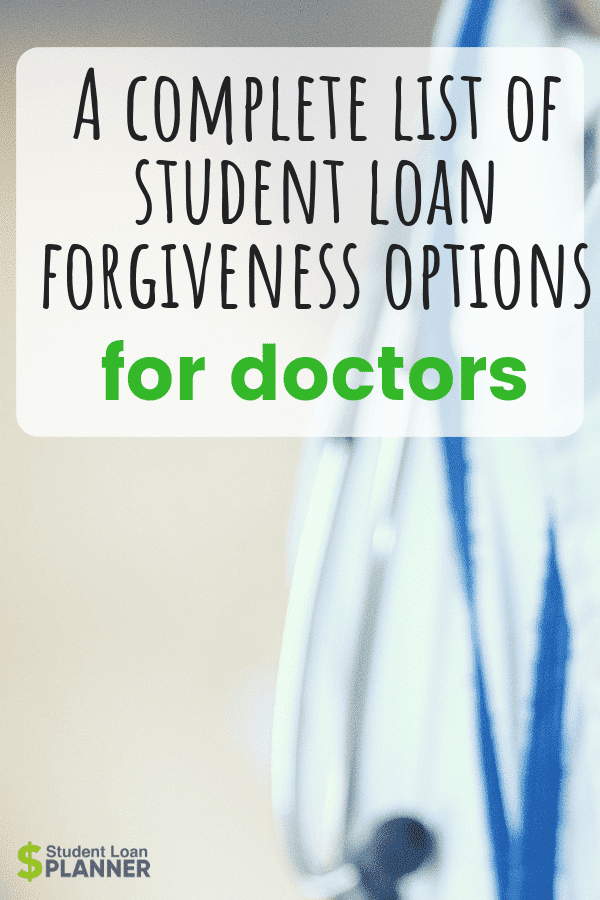According to a 2021 Merritt Hawkins survey, a whopping 34% of final-year residents said they find their educational debt “very concerning.”
These statistics sound pretty dire, but there’s also good news: Many medical school loan forgiveness options exist for doctors. If you’re willing to adjust your specialty, career, or location — or if you're just plain lucky — you might qualify for some of these programs yourself.
We’ll walk you through a complete list of student loan forgiveness programs for doctors. Find out what repayment assistance and forgiveness programs are available, what you need to qualify, how much of your loans you can get forgiven, and where to go for more information.
Federal student loan forgiveness for doctors
Going into public service offers a whole range of different programs for student loan forgiveness. Some of these are specifically geared towards doctors, while others are more general programs that doctors can still use to their advantage.
Public Service Loan Forgiveness
The Public Service Loan Forgiveness (PSLF) program is the big granddaddy of student loan forgiveness that everyone’s familiar with. This program isn’t limited to just physicians, but it is possible to have your federal medical school loans forgiven under this program.
To qualify, you’ll need to work for a government or nonprofit employer, such as the Centers for Disease Control or nonprofit hospital. When you’ve made at least 120 monthly payments while working for a qualifying employer, your remaining student loan balance may be forgiven, completely tax-free.
Income-Driven Loan Forgiveness
One of the best benefits of federal student loans is that if you’re having trouble making your payments, you can get on an income-driven repayment plan. Your student loan payments are capped at 10% to 20% of your income. There are multiple different types to choose from, and best of all, your remaining federal loans can be forgiven after 20 to 25 years.
Here’s how long it’ll take for your loans to be forgiven, depending on which program you go into:
- Saving on a Valuable Education (SAVE): 20 to 25 years, depending on undergraduate versus graduate loans
- Pay As You Earn (PAYE): 20 years
- Income-Based Repayment (IBR): 20 years if you started borrowing on or after July 1, 2014. For everyone else, it’s 25 years.
- Income-Contingent Repayment (ICR): 25 years
These plans offer the possibility of student loan forgiveness for doctors and can be very popular since there aren’t any specific requirements to qualify. But there’s one huge downside: When your loans are forgiven, that amount counts toward your taxable income.
Indian Health Service Loan Repayment Program
If you’re interested in working in a potentially remote area serving Native Americans and Alaskan Natives (not “Indians”), you might be able to qualify for the IHS Loan Repayment Program (LRP).
The IHS will hook you up with a job in a needed location for a two-year contract. At the end, you can receive up to $40,000 in student loan repayment assistance.
The best part about this program is that they’ll pay 20% toward your federal tax liabilities (state, local and remaining federal taxes are on you), and you can even extend your contract annually until your student loans are completely gone.
Get Started With Our New IDR Calculator

National Institute of Health Loan Repayment Programs

The National Institute of Health (NIH) provides a number of ways to get student loan forgiveness for doctors and other medical professionals, specifically five LRPs for those conducting research outside of NIH (extramural). These huge LRPs require a lot of patience to deal with, but it’s still worth it. Over 1,600 medical researchers per year qualify for NIH loan repayment programs, after all.
To qualify for any of the NIH extramural programs, you’ll need to work for at least two years in one of the following areas:
- Clinical research
- Clinical research for individuals from disadvantaged backgrounds
- Pediatric research
- Health disparities research
- Contraception and infertility research
Each year, the NIH awards you $35,000 to pay toward your remaining student loans and reimburses you for any taxes you owe as a result of the loan forgiveness.
Still, $70,000 might not be enough to wipe your entire debt away. For those people, the NIH also allows you to apply for a competitive renewal of your position and the benefits it comes with.
National Health Service Corps Loan Repayment Program
The NHSC offers a few different LRPs, and this is one of them. To qualify for this award, you’ll need to be a clinician participating in (or at least be eligible to participate in) Medicaid, Medicare, and the State Children’s Health Insurance Program (CHIP).
You’ll also need to agree to serve in a health professional shortage area (HPSA) for at least two years. Each one has a score. If you serve in an area with a score of 14 or higher, you can qualify to have up to $50,000 of your student loans forgiven. If you serve in an HPSA with a score of 13 or under, you’ll only receive up to $30,000.
Half-time applicants are also eligible, but they’ll only receive up to $25,000 for serving in an HPSA with a score of 14 or higher, or up to $15,000 for serving in an area with a score of 13 or lower.
One big bonus? The medical school loan forgiveness amount is not taxable, so you don’t have to worry about facing a huge tax bill after you receive the money.
National Health Service Corps Students to Service (S2S) Loan Repayment Program
If you can commit to serving in an underserved area for at least three years of full-time service or six years of part-time service, you may be eligible for student loan forgiveness through the NIH S2S Loan Repayment Program. This award is available to final-year medical students.
This LRP would be a great deal for high-balance borrowers since it repays a total of up to $120,000 worth of your student loans. If funding is available, you may even be able to extend your service to have all of your student loans repaid.
This award is also not taxable, meaning it’s entirely free money that won’t put you in more debt if you’re unable to pay a tax bomb.
National health service corps substance use disorder (SUD) workforce loan repayment program
It’s no secret that the opioid epidemic is getting out of control. To combat that, the NHSC Substance Use Disorder (SUD) Workforce LRP is working to get more people working in this critical area.
Clinicians can qualify for this LRP by committing to at least three years’ worth of full-time service in providing substance use disorder treatment services. If you complete the program, you’ll get a sweet award of up to $75,000 to repay your student loans.
Clinicians only working half-time are still eligible if they commit to a three-year service period, but they’ll only receive $37,500 worth of student loan repayment at the end.
Military student loan forgiveness for doctors
Choosing to go into the military is not an easy decision, but at least they’ll sweeten the deal a bit by helping you repay your student loans.
Army
The Army has many different LRPs available. You may also qualify for sign-on bonus, which you can use to pay off your student loans (or for a sweet convertible — but the former’s probably the better option).
The Army’s LRPs and bonuses change frequently, but here are some of the current mainstays for physicians:
- Active Duty Health Professions Loan Repayment Program: Active duty doctors can receive $40,000 per year toward student loans. You can receive this payment for up to three years in a row, meaning you could be eligible for $120,000 worth of student loan forgiveness total.
- Healthcare Professions Loan Repayment Program (HPLR): This program provides $40,000 per year for certain medical specialties, up to a total of $250,000. It’s also available to people in the Army Reserve.
If you meet the program requirements, the Army may let you claim more than one of these programs. This means you could be eligible to receive up to several hundred thousand dollars, and not all of it necessarily has to be applied to your student loans.
Navy
The Navy offers a repayment program that might help you repay your student loans:
The Health Professions Loan Repayment Program (HPLRP) is available if you’re in the final year of your residency program in a critical shortage area. The Navy will offer to repay up to $40,000 per year toward your student loans in return for a service commitment. Heads-up: They’ll hold 25% of your LRP amount to pay taxes.
The Navy also offers a financial assistance plan that isn’t specifically for medical school loan forgiveness, per se, but if you’re still in residency they’ll give you an annual bonus of up to $45,000 that you can choose to put towards your student loans.
Air Force
The Air Force only has one LRP: the Health Professions Loan Repayment Program. It’s not a constant offering, but if it is available when you’re looking to apply for it, it can still be worth it. Check with a recruiter to see if it’s still being offered.
To qualify, you’ll already need to be a doctor in the Air Force. If you’re eligible, the Air Force will pay $40,000 per year towards your student loans for two years in a row. They’ll also withhold 28% of this amount to help you pay your federal taxes.
State-Based student loan forgiveness for doctors

Many states also offer student loan forgiveness for doctors in a bid to get more physicians into rural and underserved areas. Most of these programs require several years of commitment and repay varying amounts towards your student loans, depending on the program.
California Student Loan Repayment Programs
California offers several different student loan repayment programs.
- California State Loan Repayment Program: offers up to $50,000 for two years’ worth of service in a healthcare shortage area, and you can renew it for up to $20,000 for two years thereafter and $10,000 for another two years.
- L.A. Care Physician Loan Repayment Program: offers up to $5,000 per month for up to five years for serving in this employer’s Medi-Cal network.
- Steven M. Thompson Physician Corps Loan Repayment Program: offers up to $105,000 for serving for three years in an underserved community.
Colorado Health Service Corps Loan Repayment Program
The Colorado Health Service Corps LRP requires you to serve for at least three years in an underserved area in Colorado. There are hourly quotas you’ll have to meet for face-to-face contact with patients, as well as specific requirements for the clinic you’ll be operating out of. If you can meet these requirements, the state will pay $90,000 for full-time service, or $45,000 for part-time service, towards your student loans.
DC Health Professionals Loan Repayment Program
If you’ve already signed a contract to work in an underserved area in the District of Columbia, you may also be eligible to apply for the DC Health Professionals LRP. You’ll need to work full-time in the area for at least four years, and if you meet these terms, the program will pay up to $151,849.29 towards your student loans.
Delaware State Loan Repayment Program
In return for a minimum two-year full-time service commitment in an underserved community in Delaware, you can be eligible for the Delaware State LRP. The exact factors that go into calculating your loan repayment amount vary, but you’ll receive an award anywhere from $30,000 to $100,000 total.
Iowa Loan Repayment Program
If you serve full-time for at least two years, or part-time for at least four years, in an underserved community, the state of Iowa will give you a total of $30,000-$50,000 towards your student loans through their Iowa LRP. The exact amount of this award depends on the program’s funding levels and your exact specialty.
Kentucky State Loan Repayment Program
The Kentucky State LRP is a little complex because it requires you to find a sponsor who will match the funds from this program towards your loan repayment.
For example, if your employer sponsors you in this program and you receive the maximum award amount of $80,000, your employer will foot $40,000 towards your student loans and the program itself will only pony up $40,000 of their own money. You’ll also need to be employed (or accepted a job offer) at an eligible underserved Kentucky clinic to qualify, and stay there for at least two years.
Louisiana State Loan Repayment Program
If you can agree to serve in a Health Profession Shortage Area for at least three years, the state of Louisiana's LRP will repay $30,000 per year towards your student loans (so, $90,000 total).
If you still have student loans left over and agree to stay in the area, you can renew the award for up to two years for an additional $24,000 payment. To qualify, you’ll also need to have low-income-friendly policies, such as accepting Medicaid patients, and having a sliding scale for uninsured and low-income patients.
Maryland State Loan Repayment Program
The Maryland State LRP program offers up to $50,000 per year in student loan repayment assistance in return for a two-year minimum contract. You’ll need to be a primary care physician serving in a shortage or underserved area to qualify. You can renew the award annually for a total repayment worth up to $200,000.
Massachusetts State Loan Repayment Program
The state of Massachusetts also offers an LRP. Like most state LRPs, you’ll need to commit to either a two-year (full-time) or four-year (part-time) contract in an underserved area. If you complete the program, the state will pay $25,000 per year towards your student loans. You can renew this award annually if you still meet the program requirements, up to a total payment amount of $100,000.
Michigan State Loan Repayment Program
If you’re looking for an especially large state LRP, Michigan is the place to go. With Michigan's LRP, you’ll need to agree to a two-year, full-time contract in a non-profit clinic in a Health Profession Shortage Area. For each two-year service period you complete, you’ll get $50,000 towards your student loans. You can renew the award for up to four separate two-year commitment periods, for a total loan repayment of $200,000.
Minnesota Rural Physician Loan Forgiveness Program
Rural Minnesota is a beautiful place. If you don’t mind foregoing the city, you can get some serious help from the Minnesota Rural Physician LRP in repaying your loans by choosing to practice in a designated rural area for at least three years. You can extend the award by one more year if you wish, for a total of four years. Each year, the state will give you $29,000 towards your student loans, for a maximum amount of $116,000.
Minnesota State Loan Repayment Program
Maybe rural areas aren’t for you. If you can agree to serve in a Health Profession Shortage Area instead for at least two years, the state of Minnesota's LRP will pay $20,000 per year towards your loans for full-time service, or $10,000 per year for part-time service.
Minnesota Urban Physician Loan Forgiveness Program
Not a state to be outdone, Minnesota offers yet another chance for physicians working in urban environments. Again, you’ll need to agree to work for at least three years in an underserved or shortage area. You’ll receive $29,000 per year towards our student loans, and you can stay an extra year if you want for a total loan repayment of $116,000.

Missouri Health Professional State Loan Repayment
Here’s another pretty standard LRP available to Missouri residents. If you agree to work in an underserved area for at least two years, the state's Health Professional State LRP will repay up to $50,000 total towards your student loans.
Montana Rural Physician Incentive Program
There’s not a lot of people in rural Montana, but for the ones that are there, the state has deemed there aren’t enough physicians to take care of them. That’s why the Montana Rural Physician Incentive program was started. If you agree to work in a rural and underserved area, the state will repay up to $150,000 towards your student loans.
You’ll receive an increasing payment every six months, starting out at $10,000 after six months of service and ranging all the way out to a whopping $20,000 payment after you’ve served for 60 months in the program.
Nebraska Loan Repayment Program
Depending on your specialty, if you agree to work in a location that’s been deemed a medical shortage area for at least three years, you can receive up to $60,000 per year towards your student loans from Nebraska's LRP. This amount will be reduced if you only work part-time (although they don’t specifically say what the reduction will be).
New Hampshire State Loan Repayment Program
New Hampshire’s LRP works a bit differently. They require you to find an organization (probably your employer) who will match any state LRP payments towards your loans. But if you can find a matching sponsor, you can receive up to $75,000 towards your student loans for a three-year service commitment in an underserved area.
You can also extend this award if you still meet the qualifications for another two years and $40,000. Part-time applicants will only receive $27,500 for a two-year commitment, with the opportunity to renew the award for another full year and $10,000.
New Jersey Primary Care Practitioner Loan Redemption Program
If you’re a primary care physician who can commit to serving for at least two years in an underserved area, you may qualify for the New Jersey Primary Care Practitioner Loan Redemption Program. There’s some complicated math behind how much you may be eligible for, but the total award amount is capped at $120,000 total if you extend your service commitment to a maximum of four years. You won’t have to pay federal taxes on the award, but you will have to pay state taxes.
New Mexico Health Professional Loan Repayment Program
The New Mexico Health Professional Loan Repayment Program also requires a minimum two-year full-time commitment to serving in an underserved area in New Mexico. You’ll already need to be a New Mexico resident, licensed and ready to practice to be accepted into this program. If you complete the program requirements, they’ll pay $25,000 per year towards your student loans, and you can even apply for renewal each year after that.
North Dakota Federal State Loan Repayment Program
In return for a mere two years of service in an underserved area, you could potentially qualify for up to $100,000 total in medical school loan forgiveness with the North Dakota Federal State Loan Repayment Program. You’ll also need to agree to see Medicare and Medicaid patients, among other requirements.
Related: 4 North Dakota Student Loan Forgiveness Options to Consider
Ohio Physician Loan Repayment Program
The Ohio Physician Loan Repayment program offers up to $80,000 for full-time physicians or $20,000 per year for four years if you agree to work in a shortage or underserved area for a min of two years. You can renew the contract for up to two years thereafter.
Oregon Health Care Provider Loan Repayment
If you work at a facility in a shortage area that sees Medicare and Medicaid patients, you might be eligible for the Oregon Health Care Provider Loan Repayment program. To qualify you’ll need to agree to work in the facility for at least three years, and you’ll receive up to half of your student loans paid off tax-free.
There are a few catches though: even though the program will pay off up to half of your student loan debt, each year your award can’t be over $50,000. In addition, you can’t use the funds to pay any loans from your undergrad studies. You also won’t qualify for the program if your loans are currently in deferment or forbearance.
Rhode Island Health Professionals Loan Repayment Program
It’s a bit of a mystery how much you may qualify for in loan repayment benefits under the Rhode Island Health Professionals Loan Repayment Program. That's because the agency doesn’t advertise this amount.
Presumably, you’ll have some idea before you apply and potentially make a career-altering decision. But in order to qualify, you’ll need to serve for at least two years (full-time) or four years (part-time) in an underserved area.
South Dakota Recruitment Assistance Program
Certain rural communities with less than 10,000 people in South Dakota may offer this Recruitment Assistant Program in a bid to get you to practice there.
It requires a three-year service commitment, and the loan repayment amounts are “equal to twice the University of South Dakota School of Medicine resident tuition for the four most recently completed academic years.” As of right now, that means you could qualify for up to $243,634 towards your student loans.
Related: 4 Top Options for South Dakota Student Loan Forgiveness

Texas Physician Education Loan Repayment Program
Everything’s bigger in Texas, including its Physician Education Loan Repayment Program. You’ll need to agree to work for four years in an underserved area or a correctional facility. Each year, you’ll receive an annual payment towards your student loans starting at $25,000 and increasing by $10,000 each year. By the time the dust settles, you could receive up to $160,000 towards your student loans.
Utah Rural Physician Loan Repayment Program
Details are light on Utah's Rural Physician LRP, but the program does advertise that you’ll need to serve for at least two years in a rural county to qualify. The website lists which counties are eligible and how much you may receive (somewhere between $30,000 and $120,000, depending on the county).
Vermont Educational Loan Repayment for Health Care Professionals
The Vermont Educational Loan Repayment for Health Care Professionals program offers between $10,000 and $20,000 per year towards your student loans in return for 12-24 month contracts to serve in an underserved area. Your loans will also need to be in good standing, which means you can’t be in default.
Related: 11 Vermont Student Loan Forgiveness Programs You Probably Don’t Know About
Virginia Loan Repayment Program
If you can commit to serving for two to four years in an underserved area in Virginia, you may be eligible for up to $140,000 in medical school loan forgiveness from Virginia's LRP. Applicants are approved on a first-come, first-serve basis, so make sure to get your application in early for the best odds of approval. This is a tax-free award.
Wisconsin Health Professions Loan Assistance Program
If you can commit to serving full-time for at least three years in an underserved area in Wisconsin, the state's Health Professions Loans Assistance Program will grant you a tax-free payment of $50,000 towards your student loans.
If you work in a rural area, you can also qualify for a second $50,000 grant. The “rural area” doesn’t need to be a certified underserved area — as long as there’s under 20,000 people in the community and it’s 15 miles or more away from the next city, any physician can qualify for this additional LRP.

Common mistakes when seeking out student loan forgiveness programs
You’ve seen that programs for repayment assistance and student loan forgiveness for doctors are about as variable as the number of cells in the human body. Each one has its own eligibility requirements.
Still, there are a lot of common mistakes that physicians make when applying for student loan forgiveness programs. And if one thing’s for certain, you don’t want to mess this up.
Not being persistent
If you apply for a student loan repayment program and are denied, don’t take it personally.
Just ask Dr. Jamie Feusner: it took him three tries before he was finally admitted to the NIH Loan Repayment Program where he studied the neurobiology behind body dysmorphic disorder.
“I think [they denied me twice] because I was doing a post doc, and they weren't certain that I was committed to research. Many people with clinical training leave research after doing a post doc,” he explains. “Also, I had an MD and not an MD, PhD.”
“I finally got into the program after I won a research grant. From their perspective, it showed I was committed to research.”
Being denied student loan repayment assistance is disheartening, but as your personal circumstances change -like in the case of Feusner’s grant award-staying persistent might pay off.
Not doing enough research on program requirements
The rules surrounding each student loan repayment program and cancellations can be more complex than the legal code.
But if you’re accepted into a program, it’s important to know exactly what’s required of you and what you’ll have to give up. You don’t want to be like the majority of the first cohort of PSLF applicants and find out that you don’t meet the program qualifications right on the cusp of applying for it.
Not saving up for tax implications after student loan forgiveness
A tax bomb occurs when you owe income taxes on the medical school loan forgiveness amount in the year that it’s disbursed to you. Not all student loan repayment programs require you to pay taxes on the amount you owe, but it’s always a good idea to check before you enter the program.
One thing’s for sure: you don’t want to have your loans forgiven only to have that money transformed into a tax debt. And when you’re talking about physician-sized student loan debt, that’s doubly true.
Not doing the math
Sure, a $35,000-per-year student loan repayment program sounds nice, but what if it takes you away from a $70,000-per-year higher salary in a location and a specialty you love?
It’s important to look at all of the options available to you and run the math to see which one is best. If you need help crunching the numbers and hashing through all of the potential financial implications of choosing one road over another, Student Loan Planner® can help. We can help you know your student loan forgiveness for doctors options.
After all, a small amount of time and money now scoping out each option can save you big bucks and lead to happier choices down the road. It won’t be easy, but with patience and persistence (and being willing to change your career options, perhaps), finding student loan forgiveness options for doctors is possible.
Are you going to use any of these student loan forgiveness options for doctors?
Not sure what to do with your student loans?
Take our 11 question quiz to get a personalized recommendation for 2024 on whether you should pursue PSLF, Biden’s New IDR plan, or refinancing (including the one lender we think could give you the best rate).

Comments are closed.